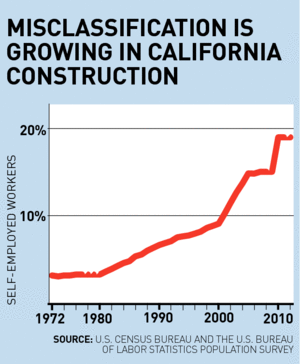
California lost more than $774.9 million in state taxes, benefits and fees in 2011 due to construction worker misclassifications and undocumented activity, says a new study by a Los Angeles nonprofit research group that was underwritten by the carpenters' union.
The report contends that 16% of California construction jobs—in a $152-billion industry that employed 895,000 people in 2012—was work done off-the-books in 2011, and it points to similar problems nationwide.
The study by the Los Angeles-based Economic Roundtable states that over 39,800 California construction workers were misclassified as independent contractors in 2011.
Resulting low wages make recruiting new industry craftsmen more difficult. California's total wage gap for nearly 143,900 "informal" construction workers, who currently earn about half what their legal peers do, totaled $1.2 billion. The state's unreported and misclassified construction work increased by 400% from 1972 to 2012, primarily in the specialty building trades, including painters, laborers, carpet installers and roofers. The recession fueled a spike in misclassified or unreported construction work.
"We see this sort of thing happening in the field every day, and we thought it needed to quantified," says carpenters' union spokesman Matt Capece. "The industry complains about the need to recruit and retain skilled craftspeople, but payroll fraud contributes to the problem."
According to the report, some employers seek "a fig leaf of legal compliance" while avoiding paying taxes and benefits by misclassifying hourly workers as independent contractors, reducing payroll costs by up to 30%.
California has over 20% of the U.S. undocumented population, accounting for 1 in 10 workers, which enables exploitative labor practices and tax evasion, the study says. Paying fair wages to informal construction workers would inject $1.5 billion into to California's economy and generate 7.9 new jobs for every $1 million spent, say researchers.
"While the report does present new information and statistics, it falls short in identifying everything currently being done by state agencies," says Contractors State Licensing Board registrar Steve Sands, who reviewed the study.
He says the agency was never contacted for study input, despite being named in its conclusions. Sands says the board "goes after those who break the law and hurt consumers, workers and California's economy."
According to the report, about 16.8% of the construction workforce in Indiana also was misclassified based on 2010 statistics, and 38% in Austin, Texas, based on 2009 data.
"Employee classification policy is a crazy quilt of state policies that are totally disparate from one another," says Robert Herrick, senior lecturer on industrial hygiene at Harvard University, who co-authored a 2005 report on "social and economic costs" of misclassification in Maine's construction industry. The state enacted a standard definition for independent contractors in all sectors in 2012.
Employee misclassification across all industries is a growing problem, especially in construction, where there is a downward pressure for contractors looking to come in with the lowest bid," says Alison D. Quesada, a labor education specialist at the University of Illinois, Urbana-Champaign.


Post a comment to this article
Report Abusive Comment